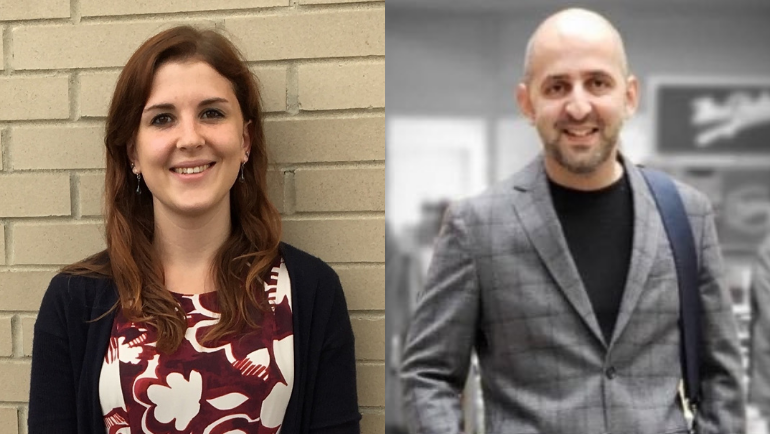
A Wayne State University School of Medicine M.D.-Ph.D. student was invited by the American Medical Association to contribute a commentary to the February issue of the AMA Journal of Medical Ethics, analyzing how clinicians should determine a traumatized patient’s readiness to return to work.
The article, written by Translational Neuroscience Program doctoral student Tabitha Moses and Associate Professor of Psychiatry and Behavioral Neurosciences Arash Javanbakht, M.D., was published Tuesday, along with an appearance by Moses on “Ethics Talk,” the journal’s related podcast.
“I think that a lot of people assume that these decisions are easy for the physician when, in reality, it can be very complex and difficult for the physician to know how to decide what is the correct choice. In this article, we aim to use clinical knowledge and evidence from research to highlight some key factors that should be considered when making these decisions,” Moses said.
The commentary looks at a case involving a psychiatrist, named Dr. Z in the article, who has been caring for a police officer, referred to as TW, who was shot while pursuing an alleged perpetrator last year in a city neighborhood of predominantly Black American residents. TW has healed physically but experiences intense, prolonged distress when discussing details of the shooting, recurrent night terrors and sleeplessness. TW tries to avoid anyone who talks about Black Lives Matter, they write, and is triggered to anger quickly by BLM banners in public spaces or on social media posts. Dr Z is not convinced that TW is psychologically ready to return to community policing duties, particularly in the neighborhood that TW patrolled before the shooting.
“This article is more than just the specifics of the case. We talk about a human who has experienced trauma and how we as health care professionals can help them manage their trauma and safely return to work in the way that is best for them while also identifying behaviors that increase risks of negative outcomes, along with providing potential alternative responses that are not associated with the same level of risk,” Moses said. “A significant portion of the population experiences trauma, and there are certain professions that are at increased risk of experiencing trauma while working. It is important that we be aware of these risks and of how to work with patients who have experienced these traumas.”
She reached out to Dr. Javanbakht for his insights as a practicing psychiatrist with experience in the areas of trauma and law enforcement. The WSU Department of Psychiatry and Behavioral Neurosciences hosts Frontline Strong Together, a state-funded project dedicated to the mental health of first responders, including firefighters, police, emergency medical services, corrections officers and dispatchers, and their families. This includes education, fighting stigma, training and prevention, peer support, treatment services and training providers.
Dr. Javanbakht, director of the Stress, Trauma and Anxiety Research Clinic, treats police officers and has been asked to complete fitness for duty evaluations for those patients.
“For the reasons mentioned in the article, I have not accepted the requests. But it has been a great pleasure to work with and serve those who put their lives on the line to serve us, in the capacity of a psychiatrist,” he said.
As a clinician, he writes that the role of the treating psychiatrist and the role of evaluator of fitness for duty can conflict.
“It might complicate the therapeutic relationship, and can put patients in situations that they might have to consider what they do or do not share with the psychiatrist/therapist as it can impact their work,” he said. “I believe the most important foundation of any relationship, including a therapeutic one, is trust, and then a mutual understanding of what are the goals to be achieved. This enables the patient and the physician to align their forces for reducing the patient’s distress, and improving their function. If one has to take on both roles, such as in situations of lack of access to other physicians who could take on one of the proposed roles in the article, this form of trusting understanding and agreement will help the patient understand the doctor is there to help them, and advocate for them.”
In the commentary, Moses and Dr. Javanbakht propose criteria clinicians should consider when determining a patient’s readiness to return to work and offer recommendations for interpreting factors that influence this decision.
“Providing education about the possible consequences of going back to work too early – detrimental impact on mental health, setbacks, and mistakes that can potentially be devastating in such sensitive occupations – can also help understand that the physician is there to support the patient and protect them against unwanted consequences,” Dr. Javanbakht said. “Then the two can work together on regaining function in the best way possible. We have also included other guidance about how such evaluations can be done best – exploring past function, current symptoms that can impact important aspects of functioning, coping skills and support, and current function in other life areas than work, as well as patient’s goals and their own concerns, fears, hopes and the meaning of the impact illness has on the functioning for each specific patient.”
A journal staff member contacted Moses to give her perspective on a case study after reading Moses’s previous article, “Erasing Trauma: Ethical Considerations to the Individual and Society.” While her graduate thesis pertains to how stress and changes in brain function are associated with substance use and relapse in people with opioid use disorder, her interest in bio-/neuro-ethics began as an undergraduate majoring in Philosophy.
“I am always fascinated by the ethical questions and issues that arise from the work we do in the clinic and the lab. I think it's important as both a physician and a scientist to be aware of these issues and recognize where they might arise and the different ways we might approach them,” she said.